

Art history - shunga. HUSTEP – The history of Japanese Art and Architecture Hokkaido University Term Paper Erkki Lassila – 07077701 What is Shunga?

History and meanings. The Floating World of the Yoshiwara - Poetry Society. Back to Archived Articles Aizuru of the Ebiya by Kikugawa Eizani, 1806.
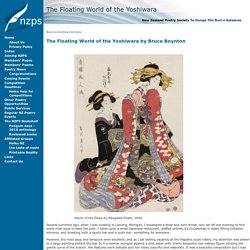
Several summers ago, when I was working in Lansing, Michigan, I developed a fever and sore throat, and set off one evening to find some miso soup to ease the pain. I came upon a small Japanese restaurant, staffed entirely by Occidentals in badly fitting imitation kimonos, and boasting both a sports bar and a sushi bar; something for everyone. However, the miso soup and tempura were excellent, and as I sat staring vacantly at the Hispanic sushi rollers, my attention was drawn to a large painting behind the bar. Woodblock Prints in the Ukiyo-e Style. Chonmage - Wikipedia. Portrait of a man with chonmage haircut from the Edo period Modern sumo wrestler with a oicho style chonmage.
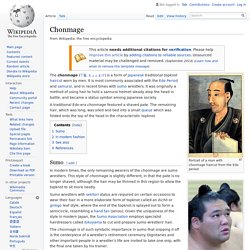
History of Kimono, Part 4: The Early Modern Period (Edo Period) With changing fashion, other changes came to kosode.
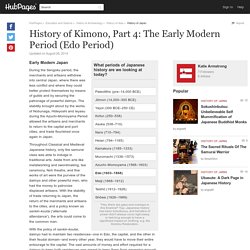
One of those changes was a structural change. Early Edo kosode had small sleeves, often sewn directly to the body of the kimono (though not always--individual kimono makers might construct the sleeves a little bit differently, so some were free in the sleeve drop). One exception to this general rule was children's kimono--a traditional belief in Japan was that children's body temperature was higher than an adults, which made them more susceptible to fevers. Children's sleeves were thus open in the back, and much larger, to improve ventilation and help keep children's temperatures regulated. Men's kimono did not ultimately follow this line of development. Japan - It's A Wonderful Rife: Ukiyo - The Edo-Era World Of Prostitution: The Yoshiwara. I have often written about ukiyo-e (浮世絵), the Japanese wood block prints that have helped define Japan throughout the Edo period (1603-1868AD), but not once have I delved into what ukiyo (浮世 - "Floating World") is.
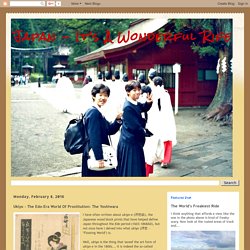
Well, ukiyo is the thing that 'saved' the art form of ukiyo-e in the 1800s... it is indeed the so-called 'floating world', but what it really means is that it's the world of legalized prostitution in Japan. I've written about prostitution in Japan a few times - just look to the right of this blog under favorites... but the world of Edo-era prostitution is a lesson in that era's moral center. I guess it's part of any era's moral center. It's said that after farming, prostitution is the second-oldest profession. The ukiyo-e to the left is owned by me, and depicts a prostitute checking her makeup. Courtesans - SamuraiWiki. Mannequins of the courtesan Agemaki and her kamuro (child attendant) from the kabuki play Sukeroku.
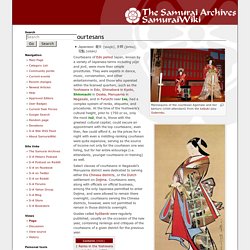
Japanese: 遊女 (yuujo), 女郎 (jorou), 花魁 (oiran) Select classes of courtesans in Nagasaki's Maruyama district were dedicated to serving either the Chinese districts, or the Dutch settlement on Dejima. Courtesans were, along with officials on official business, among the only Japanese permitted to enter Dejima, and were allowed to remain there overnight; courtesans serving the Chinese districts, however, were not permitted to remain in those districts overnight. Guides called hyôbanki were regularly published, usually on the occasion of the new year, containing rankings and critiques of the courtesans of a given district for the previous year.
Imaging Japanese History. Tokugawa Japan: An Introductory Essay by Marcia Yonemoto, University of Colorado at Boulder Sir George Sansom’s history of Japan was first published in 1932 and used in U.S. college classrooms into the 1980s.
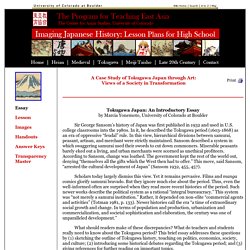
In it, he described the Tokugawa period (1603-1868) as an era of oppressive “feudal” rule. In this view, hierarchical divisions between samurai, peasant, artisan, and merchant were strictly maintained. Sansom described a system in which swaggering samurai used their swords to cut down commoners. Miserable peasants barely eked out a living, and urban merchants were scorned as unethical profiteers. Scholars today largely dismiss this view. Don’t Confuse Geisha and Courtesans (Oiran and Tayu) It is apparent from my forays around Pinterest and the web that images of geisha and courtesans are often mislabeled.
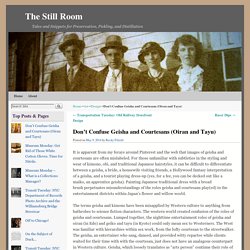
For those unfamiliar with subtleties in the styling and wear of kimono, obi, and traditional Japanese hairstyles, it can be difficult to differentiate between a geisha, a bride, a housewife visiting friends, a Hollywood fantasy interpretation of a geisha, and a tourist playing dress-up (yes, for a fee, you can be decked out like a maiko, an apprentice geisha). Painting Japanese traditional dress with a broad brush perpetuates misunderstandings of the roles geisha and courtesans play(ed) in the entertainment districts within Japan’s flower and willow world.
The terms geisha and kimono have been misapplied by Western culture to anything from bathrobes to science fiction characters. Main Page - ImmortalGeisha. Geisha and Oiran in Japan: What's the difference? This question originally appeared on Quora.

Encyclopedia of Hair: A Cultural History - Victoria Sherrow. LIFE IN THE EDO PERIOD (1603-1867) Edo (Tokyo) was made the capital of Japan by the Tokugawa shogunate.

When the shogunate set up a fortress city there around 1600 it was a small village. By 1700, it was the largest city on the world, with a population of 1,200,000, compared to 800,000 in London and 500,000 in Paris at that time. Gender Expectations of Edo Period Japan - Japan Powered. The Edo period made Japan Japan. This long segment of peace shaped Japanese gender expectations and continues to influence them today.
Kagema - Wikipedia. Kagema (陰間) is a historical Japanese term for young male prostitutes. Kagema were often passed off as apprentice kabuki actors (who were themselves often prostitutes on the side) and catered to a mixed male and female clientele. For male clients, the preferred service was anal sex, with the client taking the penetrative role;[1](p109) homosexual fellatio is almost unmentioned in Tokugawa-era documents.[1](pp121–122) The belief that the anus is a center of sexual energy that could be absorbed by the penetrative partner most likely originates within Chinese texts.[1] Kagema who were not affiliated with an actual kabuki theatre could be hired through male brothels or those teahouses specializing in kagema.[1](pp69–72) Such institutions were known as Kagemajaya (ja).
This increased interest in kagema derives in part from the increased presence of samurai-class men within cities. A "kagema" sits upon his elder patron's lap Miyagawa IsshōSpring Pastimes, 1750 See also[edit] References[edit] Edo - the EDOPEDIA -: hairstyle. [ . BACK to DARUMA MUSEUM TOP . ] ::::::::::::::::::::::::::::::::::::::::::::::::::::::::::::::::::::::::::::::::::::::::::::::::::::::::::::::::::::::::::::::::::::::::::::::::::::::::::::::::::::::::::::::::::::: Hairstyles and hairdressers in Edo - - 髪 kami CLICK for more photos !
. "Edo Graphics" Undefined text & line drawings, copyright 1997 by Lady Melisande of Hali This is a scheme of a kimono, laid out flat. And very flat they do lie. Utamaro, passionné de beauté. Note: ce billet fait partie d’une série sur les maîtres de l’estampe japonaise, retrouvez tous les portraits dans la liste ci-dessous 1.
Kunisada: le travailleur acharné 2. Utamaro, passionné de beauté 3. Hiroshige: graveur en série 4. Yoshitoshi: le fou lumineux 5. Hokusai: le vieux fou de dessin 6. Kitagawa Utamaro (dates de naissance et de mort incertaines, estimation: 1753 – 1806) On en sait peu sur la vie d’Utamaro, Ichitaro Kitagawa de son vrai nom, qui serait né à Edo vers la moitié du 18ème siècle. A ses débuts, Utamaro publia principalement des estampes d’acteurs et de théâtre sous le nom de Utagawa Toyoaki. Sa collaboration avec l’éditeur Tsutaya Juzaburo, dont il devint rapidement le principal artiste, marqua le début de la renommée d’Utamaro. En 1804, Utamaro rencontra de graves problèmes suite à la publication d’une estampe dépeignant Toyotomi Hideyoshi avec sa femme et ses cinq concubines.
Symbolism of Japanese Fans. Lovers in an Upstairs Room from Utamakura by Kitagawa Utamaro. Lovers from the series Poems of the Pillow by Kitgawa Utamaro (1788) My featured artist in My Daily Art Display today is Kitagawa Utamaro the Japanese printmaker and painter. TOKYO KNOWLEDGE : EDO LIFE - Love and Marriage in the Edo Period. Art of the Pleasure Quarters and the Ukiyo-e Style.